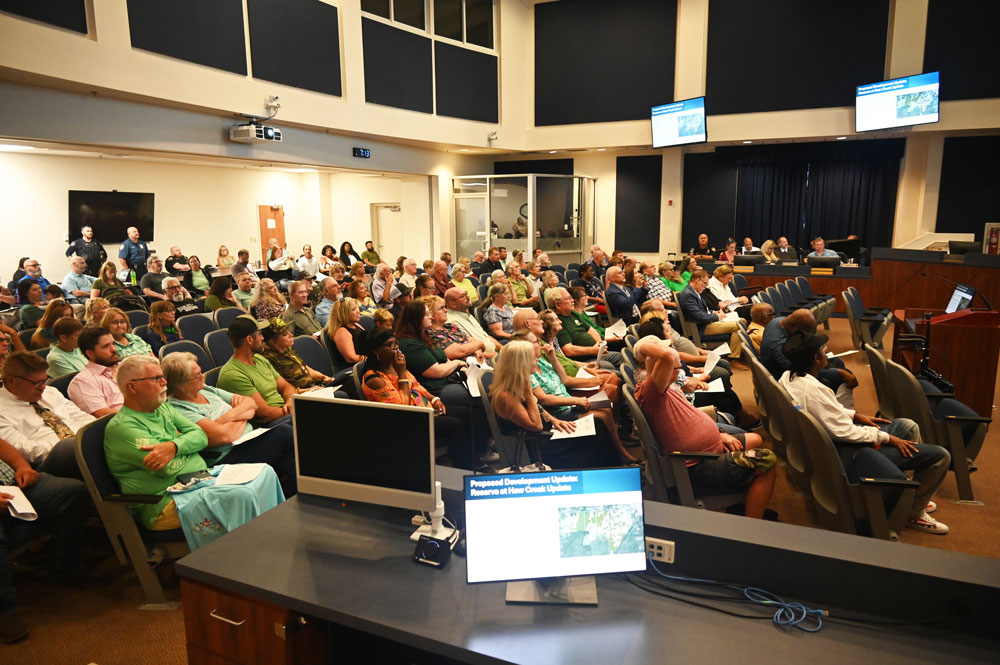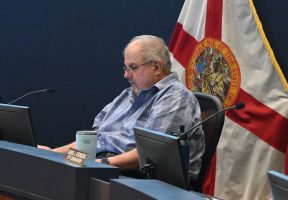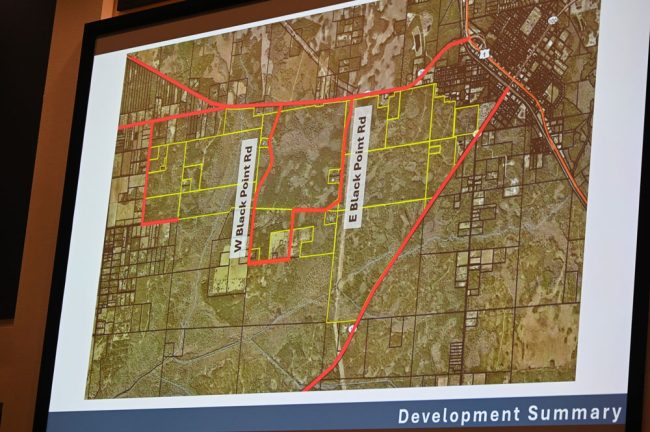
The Bunnell City Commission on a 3-2 vote Monday cleared the way for the 6,100-home Haw Creek Reserve development west and south of the city. The largest single development in Flagler County since ITT platted Palm Coast in the 1960s will surge the Bunnell’s population sixfold by build-out in 20 years and change the complexion of the city and the county, economic debacles notwithstanding.
It was a startling reversal from the commission’s 4-1 vote in June to kill the development. The reversal had taken on the shade of a done deal the moment Mayor Catherine Robinson revived the proposal two weeks later, after the developer, JM Properties of Jacksonville, led by Chad Grimm, lobbied certain commissioners, Commissioner Pete Young especially, and reduced the proposed build-out from 8,000 to 6,100 houses.
Robinson’s move at the June 23 meeting was not on the agenda. The lobbying of Young was effective.
Robinson and Commissioners Pete Young and Dean Sechrist voted to rezone the acreage and approve a development agreement. Commissioners John Rogers and David Atkinson were opposed. The split commission overrode torrents of opposition from local residents and property owners, and downplayed future traffic congestion on State Roads 100 and 11 and U.S. 1 or fears of flooding.
Audience members angrily, noisily left the room immediately after the first vote, briefly delaying the second vote. The two measures passed on first reading, with a second reading likely in two weeks.
The reduction was somewhat deceptive: when the developer first unveiled the proposal at a public meeting in May 2024, it did so on a projection of up to 6,000 homes, not 8,000. Somewhere along the line over the next few months, the number crept up to 8,000. In effect, Monday’s approval was for an increase of 100 homes over the original 2024 proposal.
Even though last night’s vote was all but foretold the moment Young reversed course in June, the resurrection filled the Government Services Building’s meeting chamber with opponents still hopeful of a last-minute surprise. They were disappointed.
“I know that you’re not happy about this, but Bunnell does need to grow,” Robinson said just before the vote at 10 p.m. Monday, nearing the three-hour mark of the meeting. “Growth is a double-edged sword. I’ve said that for many, many years. And this is where we want to go to see how this project works based on the expertise of what is looking at this.”
The commission majority repeatedly deferred to the applicant’s projections and promises, including the disproved claim that growth will help Bunnell’s finances. The developer, Chad Grimm, had brought a team of associates to make the case for the Reserve at Haw Creek (the administration placed the team’s resumes in the record).

“I think the developers bend over backwards for us. Everything I’ve asked for, they’ve done,” Young said. He wanted apartment buildings set back from single-family homes. “I don’t know if we can fix the traffic right away. I think it can be fixed. I think there’s not going to be any flooding. If it does, we’re going to fix it.” He did not say how.
“Just a few months ago, on June 9, this very commission delivered a resounding blow of not one but two opposition votes to the proposed rezoning of approximately 2,800 acres for the purpose of development of the Reserve at Haw Creek,” and the development agreement was withdrawn, Commissioner David Atkinson said. “Here we are, 11 weeks later, same commission, same developer, same concept: build it, and they will come. So what has changed in the past several weeks? From what I can see in the new and improved PUD, not much of anything.”
Atkinson listed some of the concessions by the developer, among them an offer to build a fire station, donate a fire truck, increase buffers and convey seven acres to the city for public safety uses, there will be “no specific improvements to U.S. 100 or U.S. 11,” Atkinson repeated again and again (he meant State Road 100 and State Road 11). Yet the commission in June had rejected the proposal largely based on “excessive traffic” on 100 and 11, he said.
Young indemnified the developer and placed the responsibility for road improvements on the state Department of Transportation.
“Approving this planned unit development without a financial feasibility study is just short-sighted. It’s a staggering act of irresponsibility,” Allison Nobles of East County Road 90 told the commission. “How does no analysis of long-term costs, no modeling of impacts, no public vetting of financial risk, equal financial responsibility?” Nobles was raising a recurring question: the commission was asking its residents to trust the developer’s promises, on little evidence beyond rosy statements at commission meetings.
“Hope is not a plan. The projected income is not guaranteed. We have learned that lesson with Grand Reserve,” Nobles continued, referring to Bunnell’s other large development, which had been approved on the hope that it would improve the city’s balance sheet and means of paying for better infrastructure. It did neither.
“We deserve better. We deserve leadership that asks hard questions before signing off on big promises,” Nobles said near the beginning of a public comment segment that included some two dozen people speaking for an hour and 20 minutes, overwhelmingly–but not unanimously–in opposition. Former Commissioner Bonita Robinson, for example, spoke in favor of the proposal, suggesting it would help pay future bills.
The majority of the so-called planned unit development, or PUD–1,615 acres–will sprawl with single-family houses. Apartments will take up 160 acres. Ten percent of the housing would be classified as “affordable.” A mixed-use town center-like zone will take up 50 acres (in comparison, Palm Coast’s Town center is 2,000 acres). There would be 625,000 square feet of retail and commercial space. Some 200 acres will be set aside for industrial zoning, including an RV park, just 13 acres will be devoted to public uses, with 60 percent of the overall acreage required to be green space. The project would be built over six phases.
“This project is dividing our county and our city. We have nothing to compare this to. There is no compatibility anywhere in Flagler County,” Commissioner John Rogers said, noting that there’d been a point when he was willing to make a motion to approve the project. But after listening to the presentations, “I cannot support this the way it sits in good conscience,” he said.
“Every issue that was touched on tonight is real life. That traffic is real life,” Rogers said. “You get out there every day and you deal with it. We deal with it. The flooding, when rains come, the storms come, we deal with it. That’s real life. And then the infusion of people, that’s stuff that we are going to have to deal with.”

Robinson excused the developer for not answering questions about traffic or addressing fears of flooding. “All these things that you’re questioning, it’s too high a concept at this point to be able to answer them,” the mayor said. “The next step will start to be more defined, and they will have a better understanding of what it’s going to take to make this project work. It’s not time to give specifics about US 1 and 100.”
Chad Grimm of Northeast Florida Developers, who has repeatedly spoken of the Reserve at Haw Creek as a benefit and in many ways a favor to the city, at one point suggested that without it Bunnell could see such things as meat-packing plants there. “Those become options. They are options that are out there without approval,” Grimm said. “It’s a situation where we’ve got a lot of land that’s been purchased and one way or another. You know, we have to do something with the land.”
Rogers took issue with the barely veiled threat. “With all due respect, we heard the representative speak about a plant, a meat packing plant,” he said. “Can that be done without going before this board?” Rogers was pointing out that a meat-packing plant would require regulatory review. “Just want to clear this up, because I didn’t like the tone of that myself.”
Flagler County government had raised drainage issues with the development, along with public-safety-related donations. “The county’s concerns have been satisfactorily addressed with the development agreement text that you have now,” Adam Mengel, the county’s growth management director, said.
The city’s planning board in January recommended reducing the development to 5,500 housing units.
![]()
See the Haw Creek Reserve documentation here. Audio of the full meeting discussion and votes:





























Lisa J Ferreira says
“I don’t know if we can fix the traffic right away. I think it can be fixed. I think there’s not going to be any flooding. If it does, we’re going to fix it.”
Really? Who is we? Is the commissioner aware that the fox has a price tag? That price tag is unknown. The developer county…heck even the state can model the potentially devastating impacts.
Shame on you Mayor Robinson..
. “All these things that you’re questioning, it’s too high a concept at this point to be able to answer them,” the mayor said.
Elected officials should do better.
The developer is desperate.
These actions by the commission raise many red flags.
The PUD should be including all possibilities. Otherwise all you have is just a hope or promise.
Jay Tomm says
4-1 in June to kill it, now 3-2 to keep it? Those that approved should be investigated!
Dennis C Rathsam says
1- Who greased Peter Youngs palm, something smells like rotten fish! Could it be free meals at Cracker Barrel? 2 I don’t think Harris Grocery, can meet the needs of all these families. 3 Who was the lawyer that brokered this deal? 4 Wheres the water comming from to sustain all these new homes? Look at all the new homes being built on the way to Bunnell, on the right! Miles of new homes…. The builders cant sell the homes now, here in P/C! Every street has a home 4 sale, some 2 or 3! If you cant sell homes in P/C, your not gonna sell homes in Bunnell…. Who wants to live in Bunnell?
Stop The Insanity says
The fact that the number of homes for this project keeps changing, is evidence to me that they haven’t given much thought beyond the greedy developers getting whatever they want. Business as usual around here. Nevermind the environmental impact a project of this size will have on the community. All one needs to do is look at what’s going on in Palm Coast. Developers have been giving out pink slips. Why? Because home sales are way down. So before we lose another tree to stupidity, I’d think about my next move.
T says
Disgraceful
Wow says
Who’s going to buy all these houses? It’s not like Flagler County has a booming real estate market.
FedUpWithFlaglerCounty says
Follow the money. I’m quite sure you’ll find that those commissioners who approved this debacle have increased their wealth tremendously.
Robjr says
It would be nice if the Florida lottery was as predictable as politicians.
I’m reluctant to say I told you so ,,,,, but I told you so.
https://flaglerlive.com/bunnell-mayor-revives-haw-creek/#comment-3589010
Really annoyed says
I guess the pay off was much more now than before! Corruption at its best!
Pogo says
@Welcome to Bunnell-a-Lago
… you have sown, now you shall reap.
Thomas Allen says
Add these 6100 new homes to the 19,000 currently permitted in the county to be built. It is all about the developers and money. RT 100 is already in gridlock. This is all a disaster unfolding before our eyes.
Tom Hartman says
We don’t need more homes in Flagler County, we need JOBS. High paying jobs besides retail and medical. Everyone has to travel outside Flagler County for industry. There are enough homes sitting on the market and planned for development in Palm Coast.
Keep Flagler Beautiful says
They THINK they can fix the flooding if it happens, and they don’t really know how to address the massive road congestion this project will bring, but they voted for it anyway? And the only alternative being hinted at is filthy, polluting meat packing plants? Is it a coincidence that the home builder is based in Jacksonville, where public outcry has so far stopped the building of a massive meat packing plant near residential neighborhoods? There is no such thing as coincidence when it comes to developers who stand to make hundreds of millions of dollars. Bunnell’s mayor sounds astoundingly naive, and that’s putting it politely. I don’t know how any of the world-class thinkers who voted for this atrocity can show their face in public, now. What a tragedy for Flagler County.
Greg says
I am putting my Home up for sale and getting the hell out of here! I never seen such a corrupt development in Flagler County. They won’t be happy till the whole county is solid concrete and asphalt strip malls car washes and gas stations so long Flagler County. !
Disappointed local says
Greasy slimy greedy bastards.
Land of no turn signals says says
Don’t fret people,with all those impact fees and all the new house taxes coming in our property taxes should drop significantly.Yea right
Pamela Andrews says
Saying they will address the flooding, when it happens is absolutely insane, when Daytona North floods and no resilutions there, so how can there be any better or more assuredly worse…
They cannot control traffic issues now either…
Once going from here to the beach, maybe 20-25 minutes, now takes almost an hour.
Driving State Road 100 from US 1 is miserable.
I think now it’s much easier and less stressful to drive to Palatka for groceries and such.
How the council allows this means we need to be sure they are all replaced with more reasonable thinkers…
Roger says
I think the plan is for Jacksonville to absorb Saint Augustine and Palm Coast and be the biggest city in the country! Mega city. Who in the heck wants to live in there? I think Greg was right. It’s time to sell out and find a little greener and quieter pastures this is beginning to look like Orlando Scale plus more.!
Sunny side says
Keep building till normal people can afford one! Don’t hate! Blackrock owns half the houses and doesn’t mind them being empty so have to keep building till an average family on average wages can afford a home!!🏡
Oranges Forced depression will be good for young people that are priced out housing market lol. After it all crashes of course!!!
Atwp says
They are going to fix the flooding problem. They are fooling themselves. Uprooting grass, cutting down trees, moving sand increase flooding potential. Cutting down trees increase wind damage potential. Time will tell what happens.
Jessica says
That’s why we need to vote these city idiots out of the office. For years they have continuously tried or have went behind our backs and approved shady things the people that live here done wants. They are trying to change this town way too fast and too much.
Laurel says
Ah yeah, good ole “growth.” It will fix everything. Stop and think about it. With a addition of approximately 16,000 people, in a small town, just how does that fix anything? All those new people will not require services, roads, drainage? Believe me, taxes will not go down. Where else do you know of that was *fixed* by growth?
Again, your representatives don’t give a damn what you want or think. They just proved it to you. It’s all about the money, and you, your quality of life, the wildlife are all just in the way.
Vote ’em out, and be more careful who you pick next time…or…run yourself!
Sick of It All says
Wait until the wild hogs get wind of this. There will not be a lawn left in many of the nearby neighborhoods. It isn’t going to be pretty. Anyone living near new construction can attest to that.
Concerned Citizen says
I knew this was going to happen.
Some one needs to investigate their bank accounts. Some folks are going to retire off of this decision.And leave it for some one else.
Yes Mrs.Robinson et Al. That was directed at you all.
Keep Flagler Beautiful says
Just wondering where the developers think the children living in those 6,100 homes will be going to school. Our existing schools are pitifully run down and inadequate to serve the existing students, unless you call prefab portable classrooms acceptable, which I do not. It would take probably 10 years — maybe more — of accrued property taxation on ALL 6,100 homes before the tax burden of new-school construction could be lifted from the shoulders of Flagler County taxpayers. In the meantime, all students would suffer from the overpopulation. Do the City of Bunnell’s Commissioners have a solution? I don’t suppose they thought of placing a condition on the developers to build elementary, middle and high schools within their nightmare development. I, for one, do not plan to stick around for this train wreck, or for the flood zone it will create for a large part of the county. I once loved living here, but I’ve had enough.
Mary Lumas says
Money talk wish I could say I’m shocked. So sad and as usual animals and traffic have to suffer..
NJ says
“We the People” of Bunnell (and all of Flagler County) have LOST; while the Realtor/Contractor/Developer CARTEL have WON.
Greasy Paws says
So GREASY!!! Now, are these homes going to draw water from palm coast water plants? Does Bunnell treat its own water?
Take a Good Look says
DESPICABLE!!!! MORONIC!!! ASSININE!!! And downright SINFUL!!!
Corn and Taters says
When you go to the podium and state your name 3x but the Commissioner that has known you since 1974 doesn’t know you??!! Then said Commissioner casts vote to change the face of Bunnell for life. Can anyone say COMPETENCY?
The Geode says
Somebody GOT PAID $…
Bunnell Local says
Why did George Allen deed this land to JM Properties? Per Sunbiz, the managing members of JM Properties X, LLC have local addresses. It’s not even out of towners destroying our land. How incredibly sad.
Rick says
Protest this abortion to COME, and investigate everyone’s Bank accounts. Someone was paid off.
No concrete resolutions were presented for flooding and traffic.
Only incompetent FOOLS would approve this without resolutions presented – Disaster Ahead, and all that created same will be gone, with pockets full !!
Gail Zega says
All of the citizens need to band together, appeal this decision and get a good attorney to deep dive into all of this…and no mention at all of the wildlife corridor this disrupts…how could this possibly be legal? The entire state is corrupt and doesn’t give a damn about quality of life, just killing everything for $$$$$. GET THAT ATTORNEY!!!